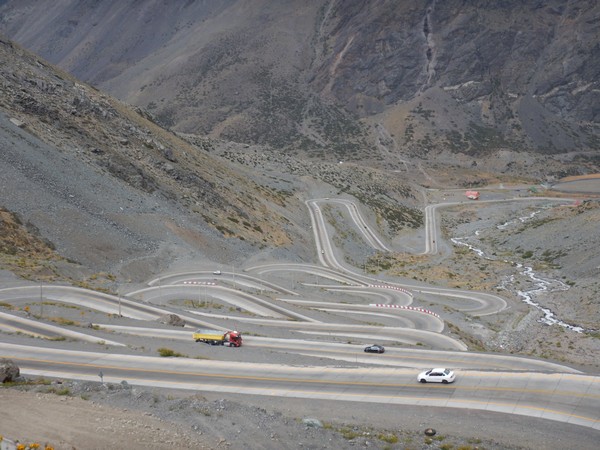 After spending just over a month cycling nearly 2000 km through Argentina it was time for the biggest challenge – to cycle from the lowlands of Mendoza over the Andes mountains to cross into Chile via the Paso Internacional Los Libertadores.
After spending just over a month cycling nearly 2000 km through Argentina it was time for the biggest challenge – to cycle from the lowlands of Mendoza over the Andes mountains to cross into Chile via the Paso Internacional Los Libertadores.
It should take me about 3 days of climbing to complete the +200km ride to the summit of the pass, which forms the border with Chile, before enjoying 2 days of descending to reach the Chilean capital city of Santiago. The total amount of climbing would be close to 4000m of actual ascent and would be a good test of my legs.
The night before setting off on this final South American adventure I had slept at the beautiful Bodega Cecchin in the wine region of Maipu, which lay 20km south of the more famous city of Mendoza.
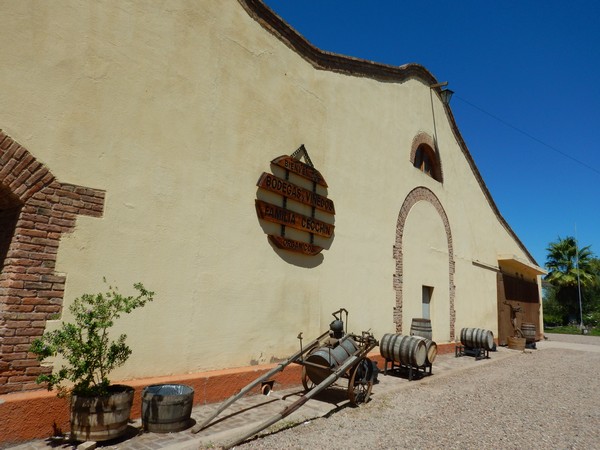
Breakfast was taken at a table in the middle of the grape vines and my view was of the snow capped Andes Mountains which looked beautiful from where I was sat.
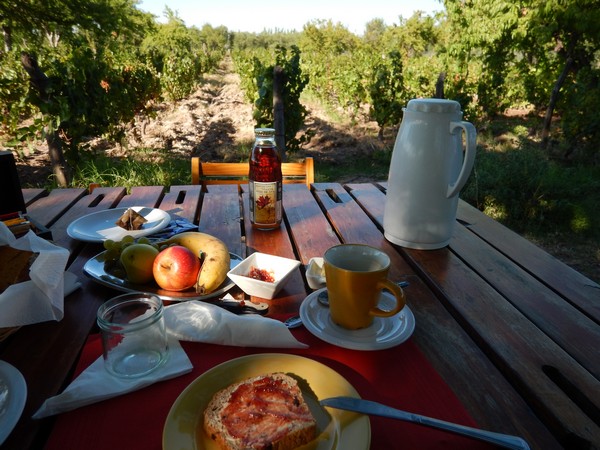
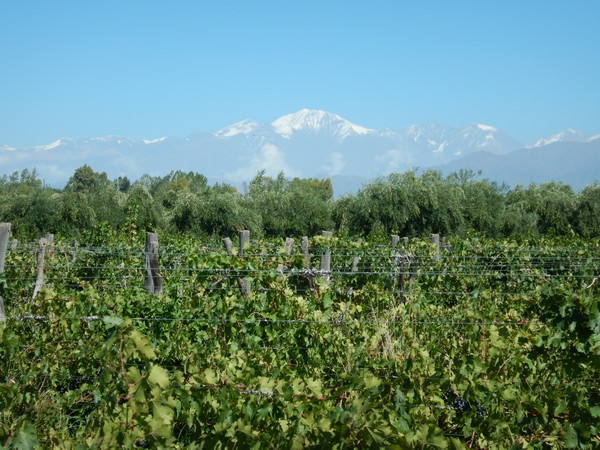
When I set off the quickest way would have been to cycle for a final 15km on Ruta 40 but as it was an Autopista (like a motorway) at that point I decided to stick to the side roads which were more picturesque.
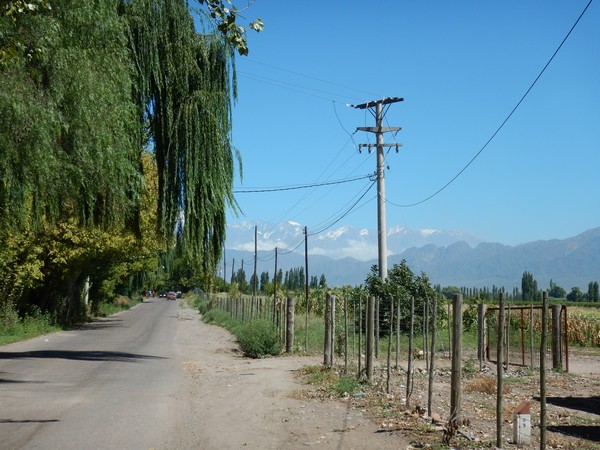
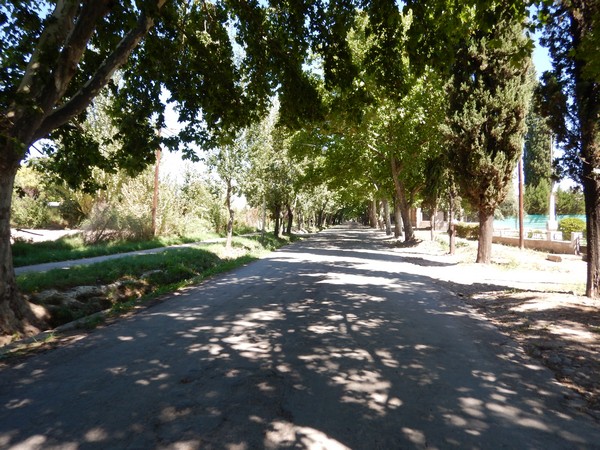
Beneath the Andes are huge oil and gas reserves and near to Mendoza is the geological formation called the Vaca Muerta, (translates as Dead Cow) and for the first time in nearly a month I saw evidence of oil extraction as I cycled through an oil field that lay in the foothills of the Andes.
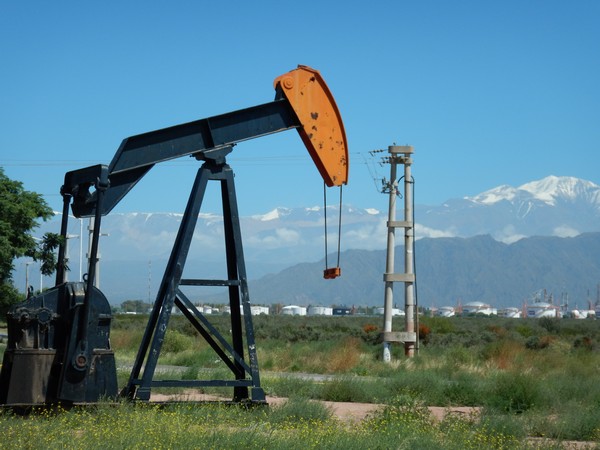
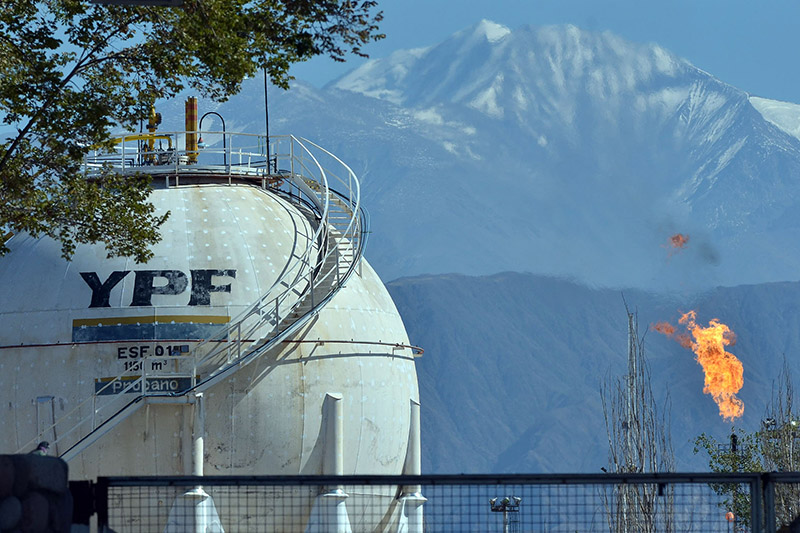
On my map there were no villages for the next 60km so I took advantage of the restaurants that were near to the oil refinery to have an early lunch and to top up my water supplies.
It was then time to get on with the not too small a task of cycling over the Andes. Today, though was about negotiating my way through the foothills that you can see in the foreground of the photo below rather than the main peaks which lay in the background.
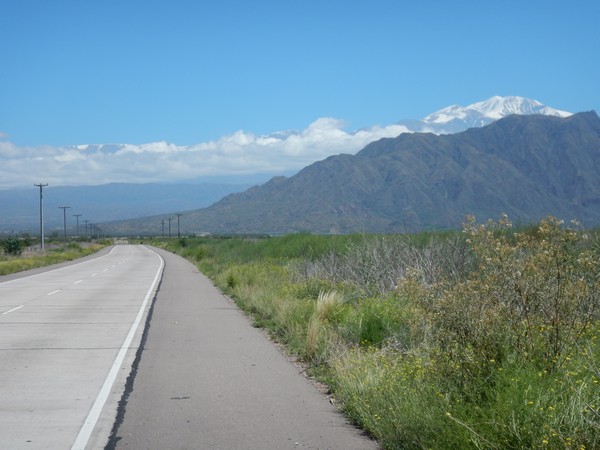
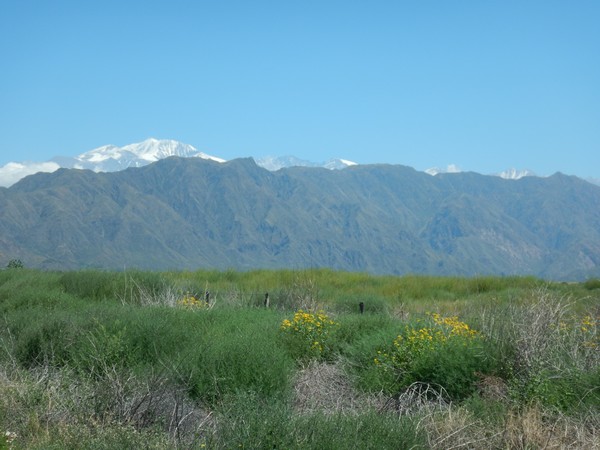
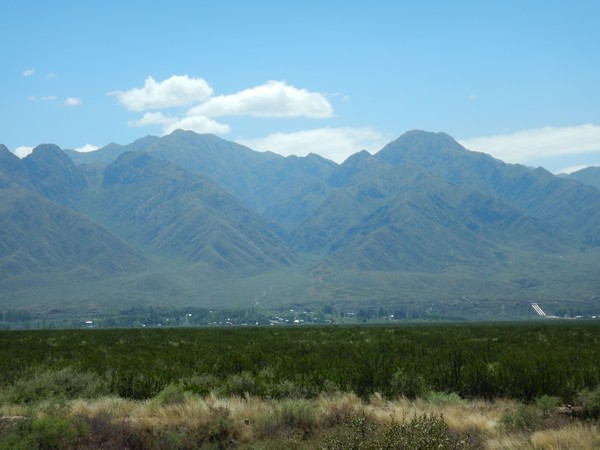 Although the road rose for most of the day the gradient was not too bad.
Although the road rose for most of the day the gradient was not too bad.
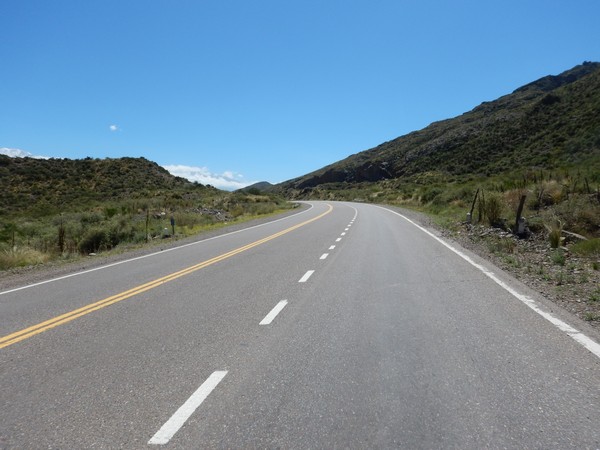
The problem now that I was cycling directly west was the wind. It was ferocious and all day it would keep pushing me off the road when it gusted.
After climbing all day the final section, near the village of Potrerillos, was a downhill run to where the River Mendoza has been dammed to form a hydro-electric lake.
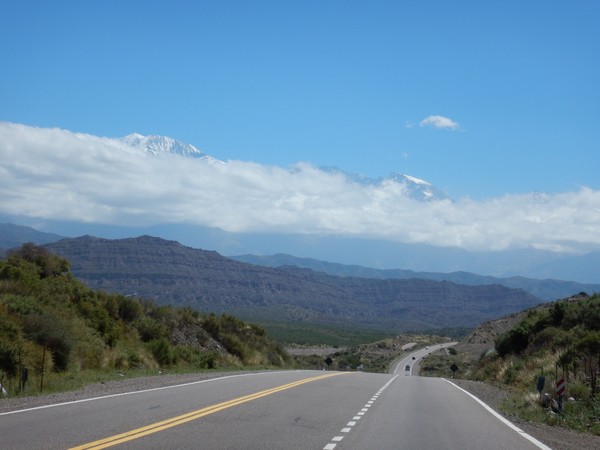
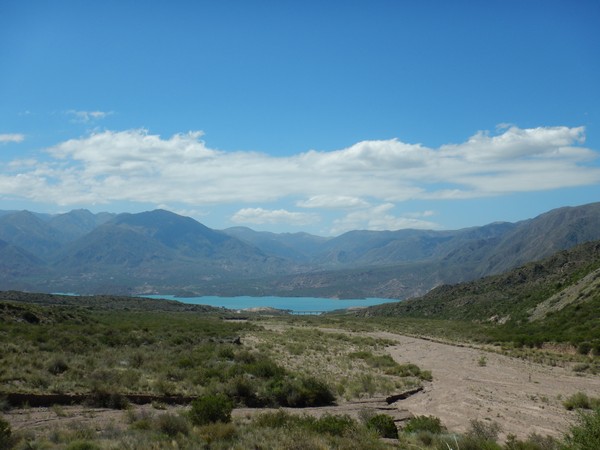
It was early evening when I arrived at Potrerillos and the lake looked stunning 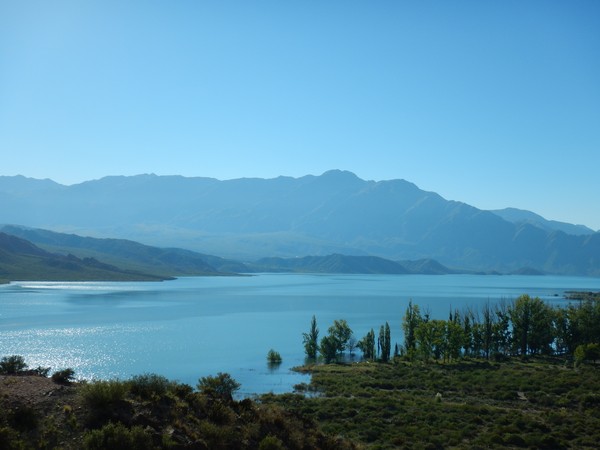
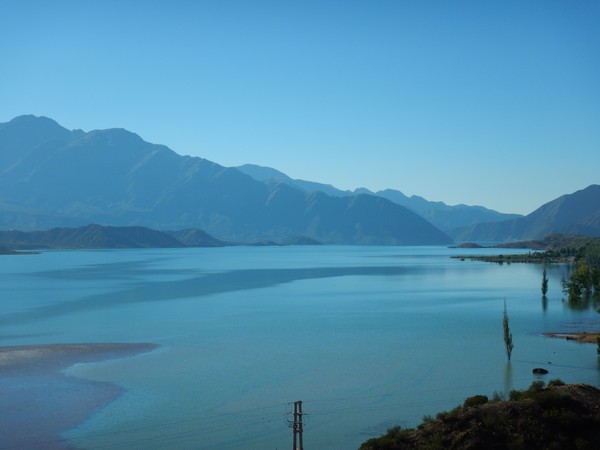
I knew from cyclists that I had met a week before that there was an ACA campsite (Automovil Club Argentine) in the village that was on the shore of the lake. When I cycled into the site it was in a beautiful location but at 170 peso they were definitely charging a premium as this was nearly double the normal price of a campsite.
The campsite was pretty empty apart from one school group that had taken over the northern end of the camp ground.
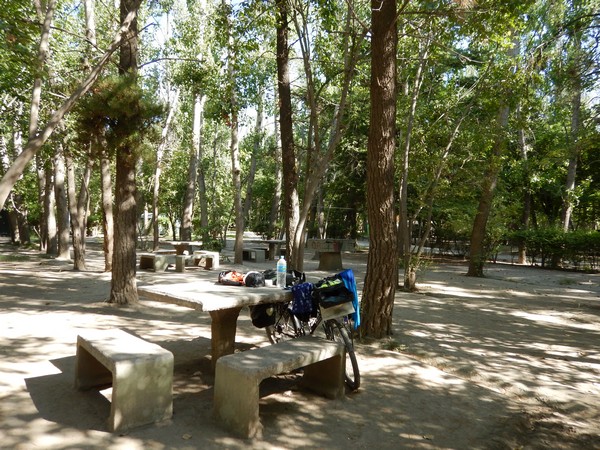
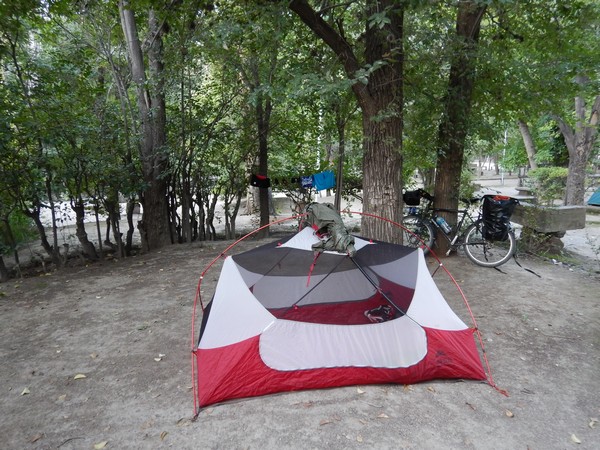
The kids were primary aged and in the evening instead of the normal Argentinian campsite dance tune rhythm the kids had a talent show and afterwards they all sat around singing traditional songs. By 10pm the campsite was silent and I had a great night’s sleep.
The next morning when I set off the first few kilometers of road skirted the edge of the lake and was beautiful.
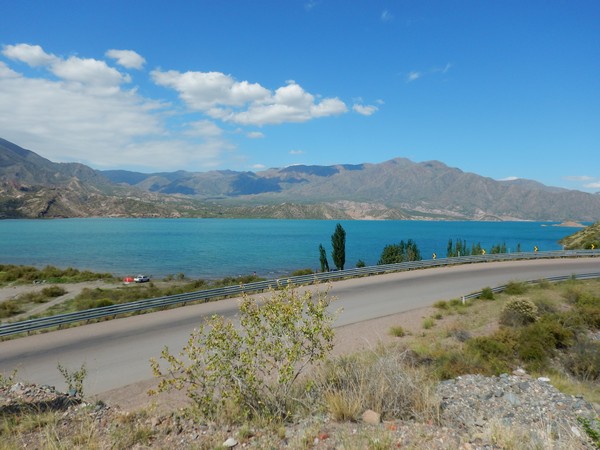
At the end of the lake the road followed the river valley up into the high Andes.
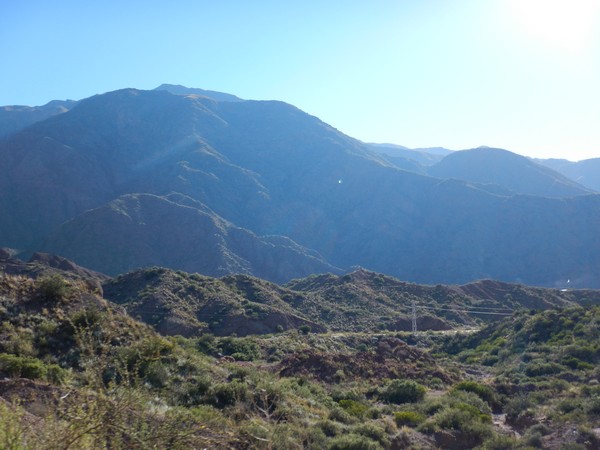
The hills were starting to look pretty big now that I was surrounded by them on all sides.
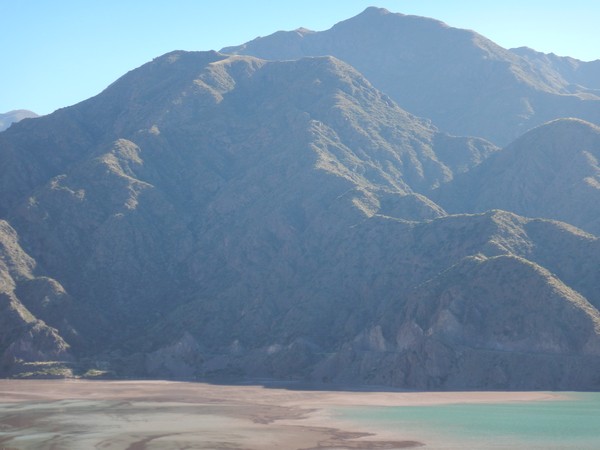
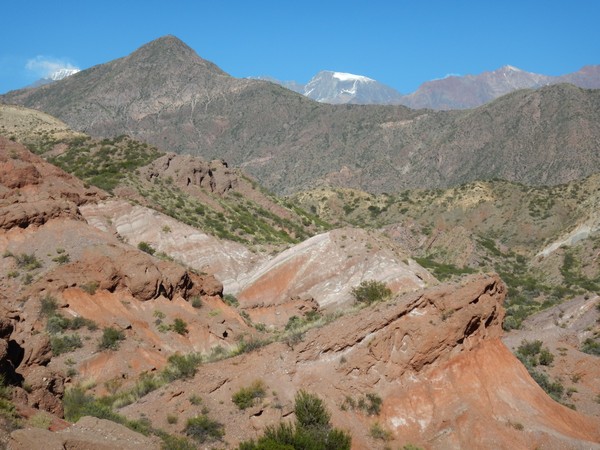
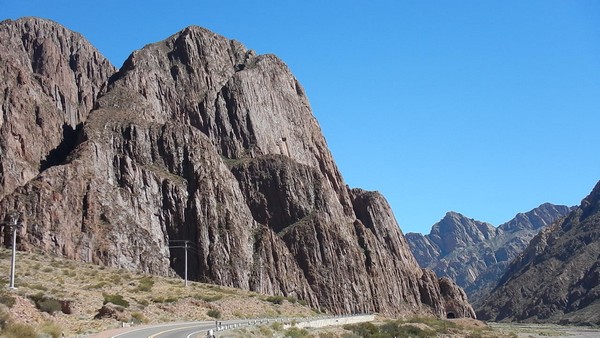
The wind was also funneling the westerly wind that was blowing and I was once again constantly being pushed off the road. At times I could ‘fight’ the wind by leaning my bike over at a crazy angle to keep riding in a straight line whereas at other times I had to stop and stand with both feet on the ground just to keep the bike upright.
All day I followed the river valley as it wound it’s way higher and here is a selection of photos to show you how utterly gorgeous the ride was that morning.
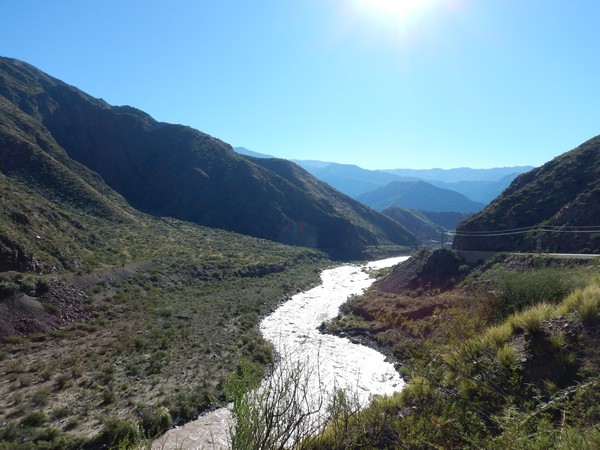
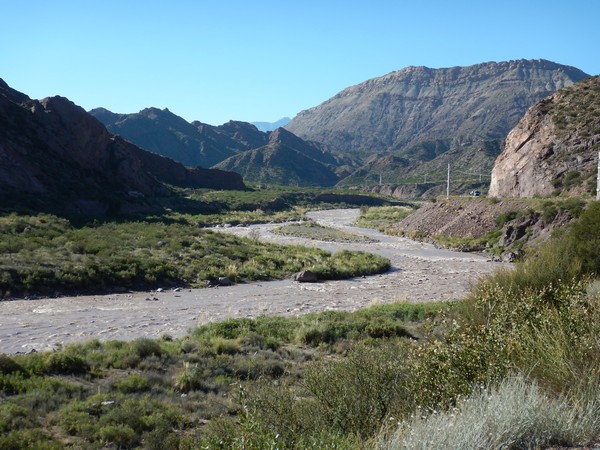
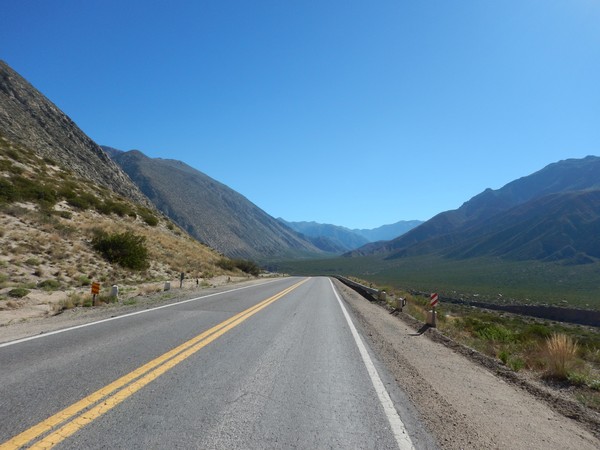
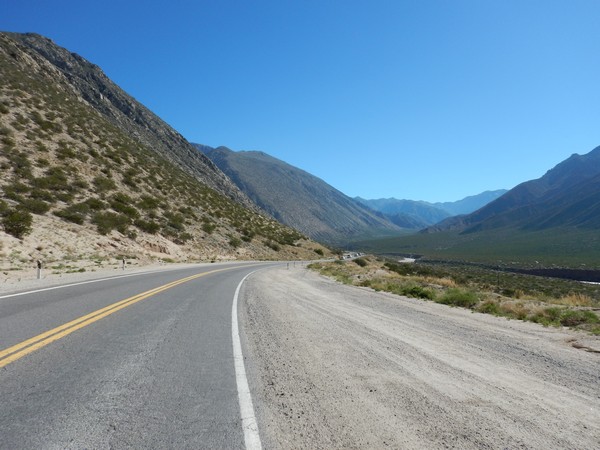
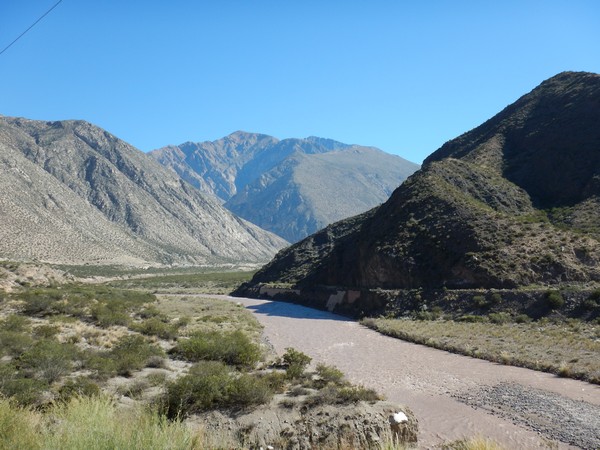
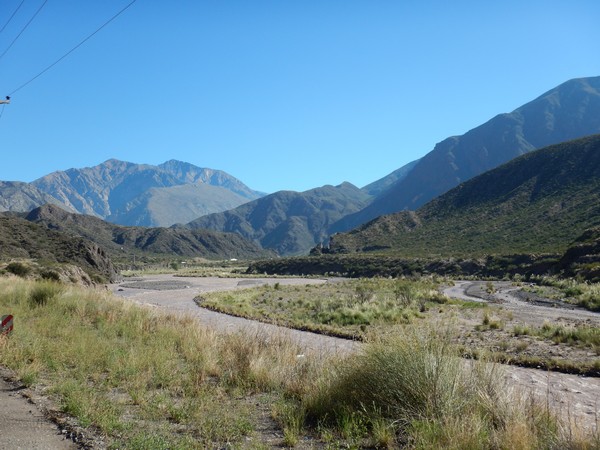
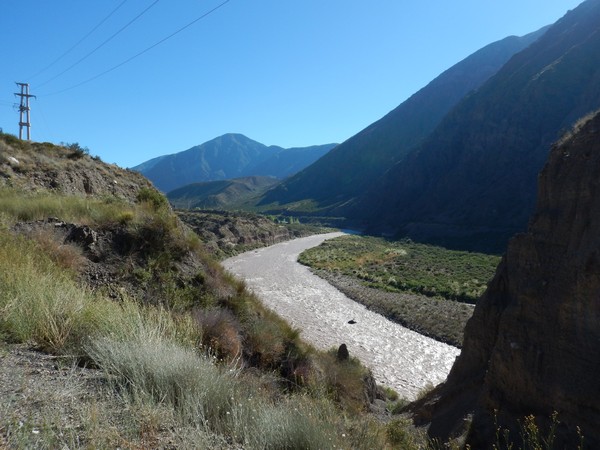
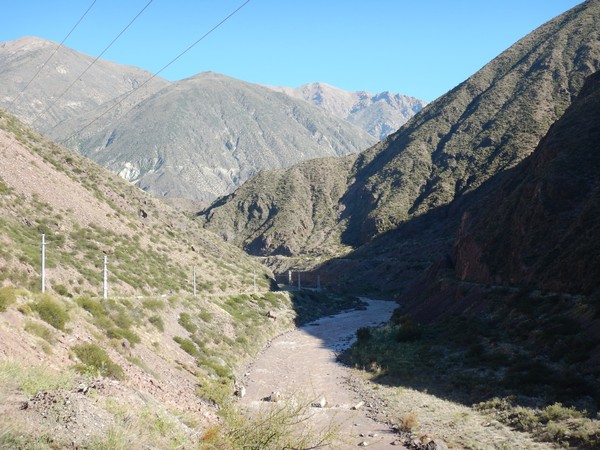
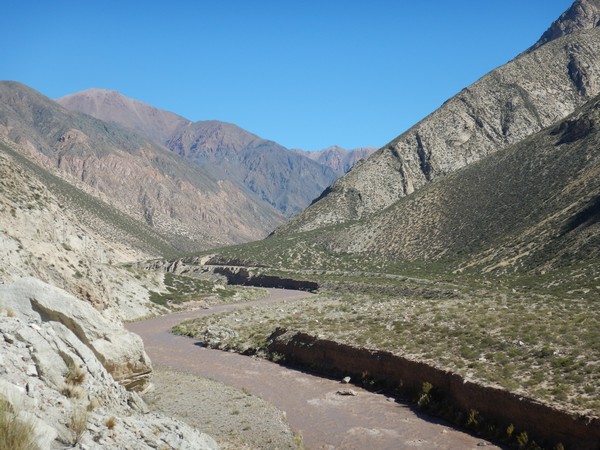 Also winding its way up the valley was a disused railway – The Transandine Line. The 250km section of rail track over the Andes between Mendoza and Santiago followed the ancient mule train route. Construction began in 1887 and took 23 years to complete which including the blasting of the ‘Cumbre’ tunnel through the mountain pass which is used by road traffic today.
Also winding its way up the valley was a disused railway – The Transandine Line. The 250km section of rail track over the Andes between Mendoza and Santiago followed the ancient mule train route. Construction began in 1887 and took 23 years to complete which including the blasting of the ‘Cumbre’ tunnel through the mountain pass which is used by road traffic today.
A glacial flood on the Argentinian side destroyed 124km of the line in 1934, but this was rebuilt and the railway was used to transport passengers and freight across the border until the end of the 1970’s.
During tensions between Chile and Argentina in 1978 all international railway use of the Transandine Railway was suspended and the Chilean military, fearing an invasion from Argentina, prepared to destroy key sections of the railway line, including the Cumbre tunnel.
With the relative normalisation of relations between the two countries railway passenger services through the tunnel were resumed for a short period but these ended in 1979 and the last freight train ran in 1984.
Today, despite frequent discussions about rebuilding the railway for passenger trains the tracks are slowly crumbling away and although some of the rail bridges that span the river are still intact, and are even used by trucks today to cross the river
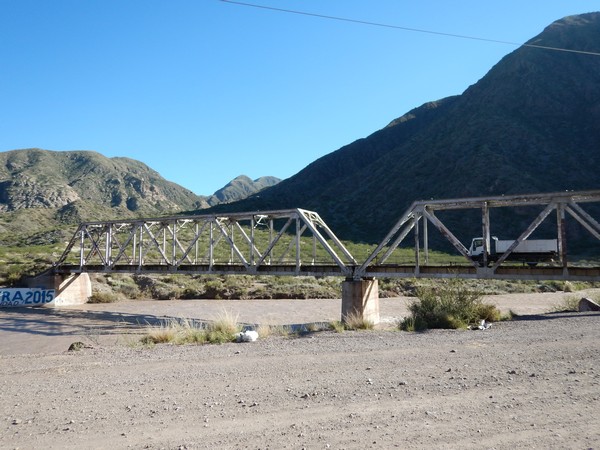
Others are slowly being washed away
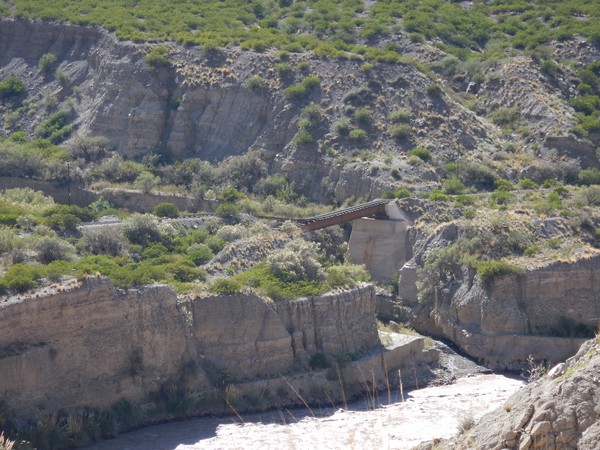
Every now and again I would pass derelict railway stations that were again slowly crumbling away.
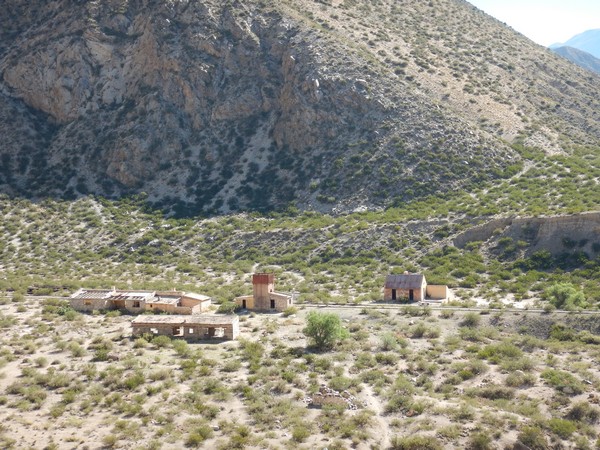
The other constant that lined the edge of the road were plastic bottles and some of the piles were huge
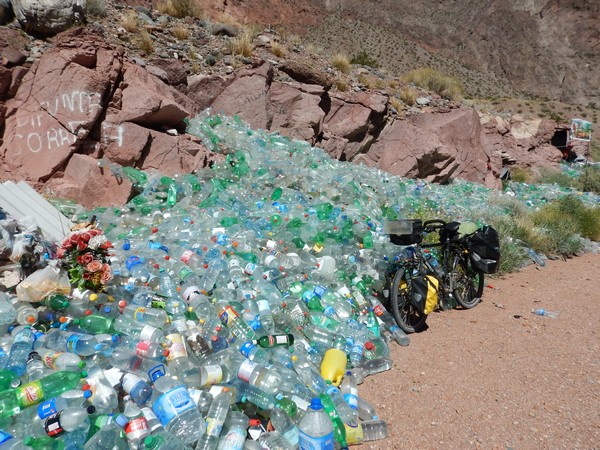
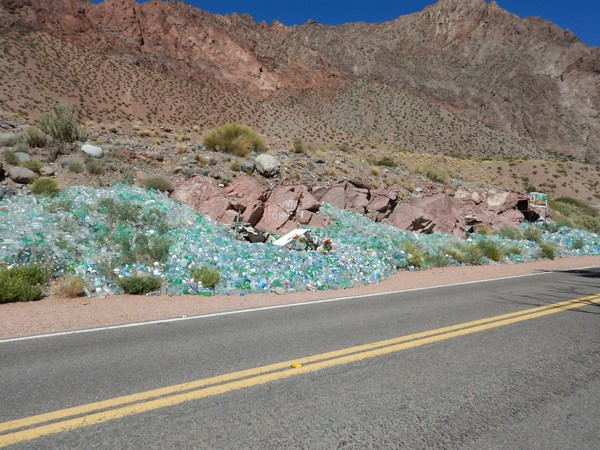
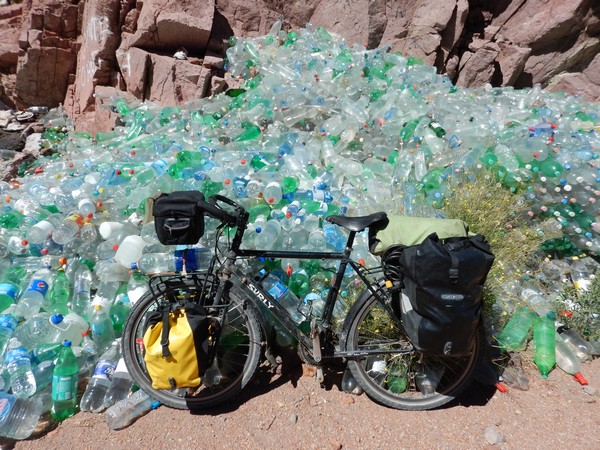
They were not rubbish that had been thrown from passing traffic but offerings that had been placed next to shrines.
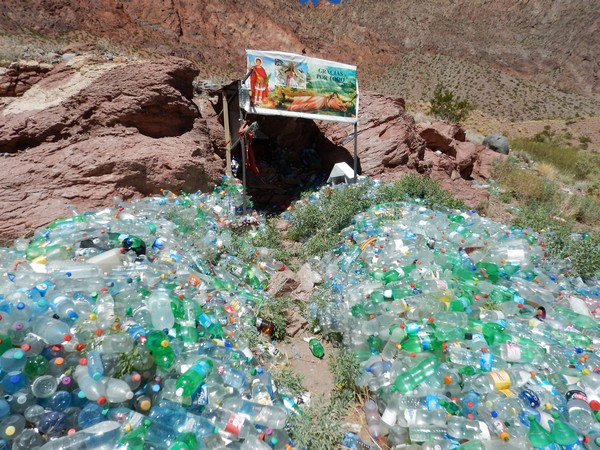
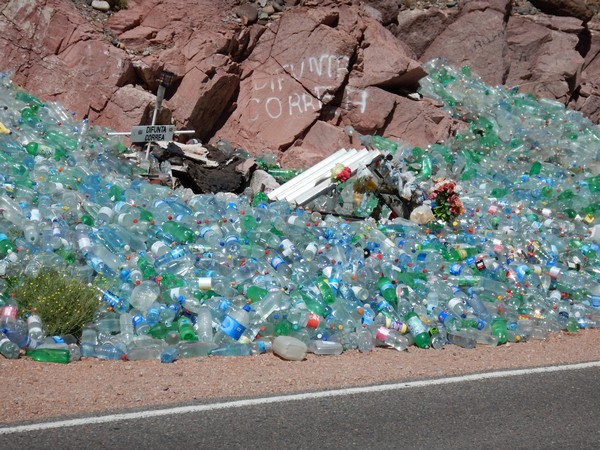
It turns out these are shrines to La Difunta Correa who died in the 1840’s. According to legend during the Argentine Civil Wars the husband of Deolinda Correa was forcibly recruited. When he became sick, he was abandoned in the desert by the Montoneras [partisans]. In an attempt to reach her sick husband, Deolinda took her baby and followed the tracks of the Montoneras but her supplies ran out and she died.
Her body was found days later by gauchos (cowboys) who were driving cattle through the desert. They were astonished when they saw the dead woman’s baby was still alive, feeding from her “miraculously” ever-full breast. The men buried her body in present-day and took her baby with them.
Cattle ranchers and cowboys built small altars to La Difunta Correa, The Deceased Deolinda Correa, along several routes throughout the country, with images and sculptures of the Deceased. Today, this tradition is continued by truck drivers who leave bottles of water as votive offerings “to calm her eternal thirst”.
To show you how big the piles were take a look at this short video:
As I continued my ride ever higher the snow lined mountain peaks that marked the border with Chile that had yesterday seemed to be way off in the distance were now much closer
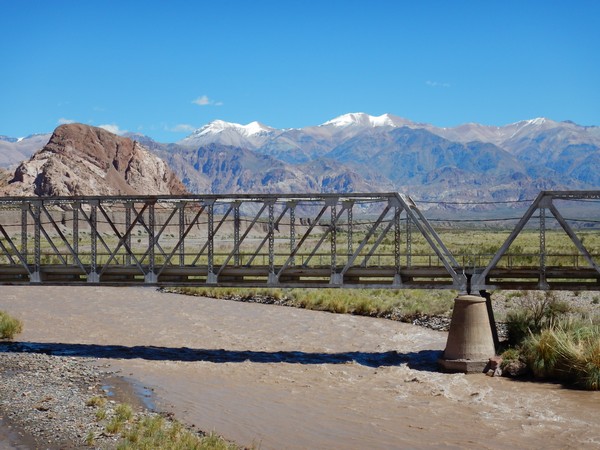
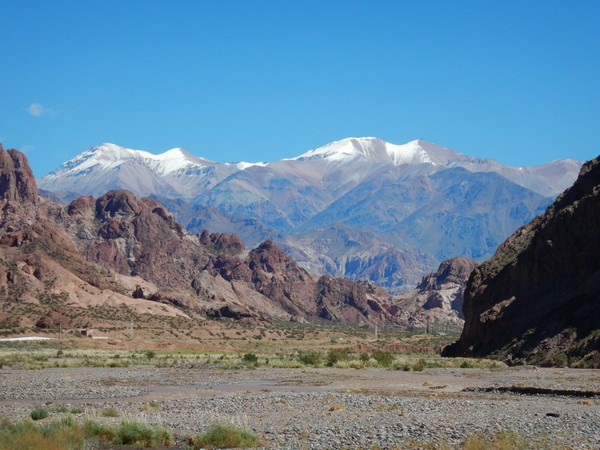 I wanted to reach the town of Uspallata before I stopped for lunch. When I started that morning it had lay 50 km away which I should have easily reached by 1pm.
I wanted to reach the town of Uspallata before I stopped for lunch. When I started that morning it had lay 50 km away which I should have easily reached by 1pm.
The wind was killing me though and even in the more protected parts of the valley I was following it was fairly dangerous to be riding at more than 15kmph as the few times that I had tried crazy gusts would hit me making the front end of the bike uncontrollable and push me straight off the road.
The other problem were the tunnels that lined a 10km section of the road. When I cycled through these there was no track to the side of the road and with the wind howling through them I was at times reduced to 5 or 6 kmph.
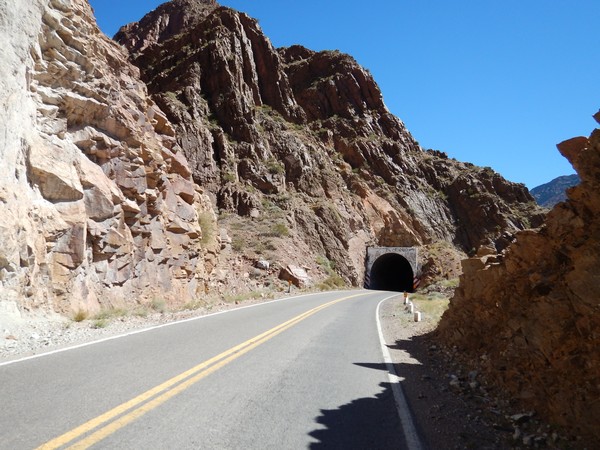
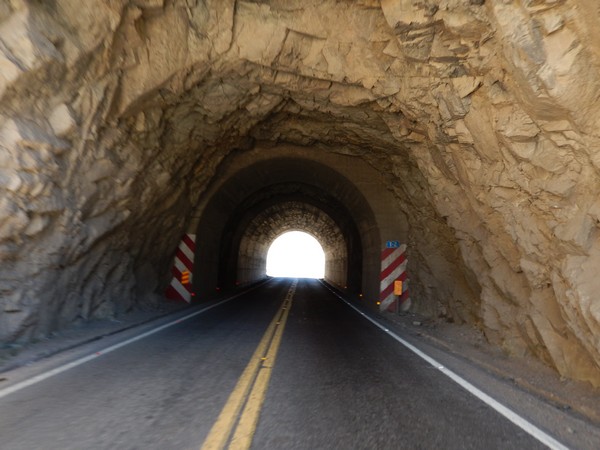
Not the most ideal scenario when the tunnels were mostly unlit and cars and trucks came barreling through them at 100kmph and would only see me at the last second. Where possible I would wait at the entrance until I could not see or hear any traffic behind me and then go for it. This worked fine on single tunnels but was much harder when there was a line of a few of them back to back.
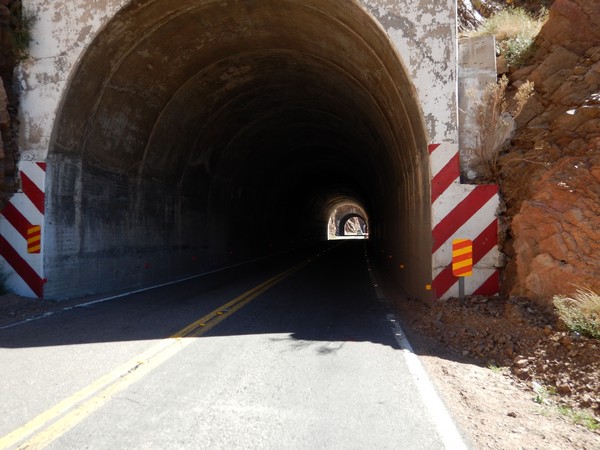
Being in the dark though meant that the exits to the tunnels were pretty beautiful as the small speck of light at the end slowly grew into a beautiful view of the mountains the closer I got to it.
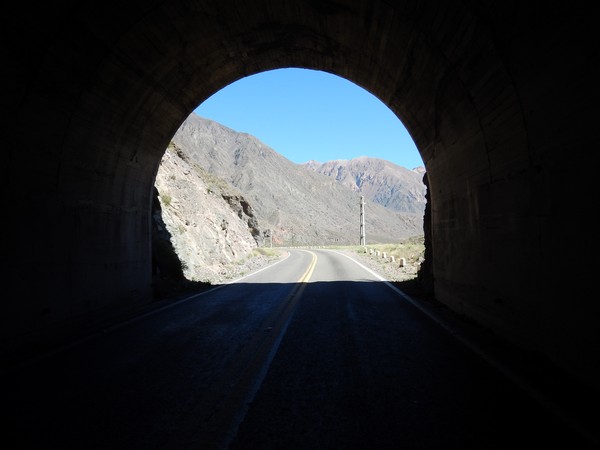
It was nearly 2pm when I rolled into Uspallata and found a place that was still serving food as by now it was ‘official’ siesta time in Argentina.
I grabbed a quick sandwich and a coffee as the strength of the winds always got worse in the afternoon and after setting off again the road turned 90 degrees so that the gusts would no longer be coming from my left but predominantly from my right. This meant that instead of pushing me off the road they would be pushing me into the middle of it.
I was back on the bike by 2.30pm and heading out of town at a pace which can be best be described as a crawl. I had lost the protection of the mountain slopes and was cycling down the centre of the river valley.
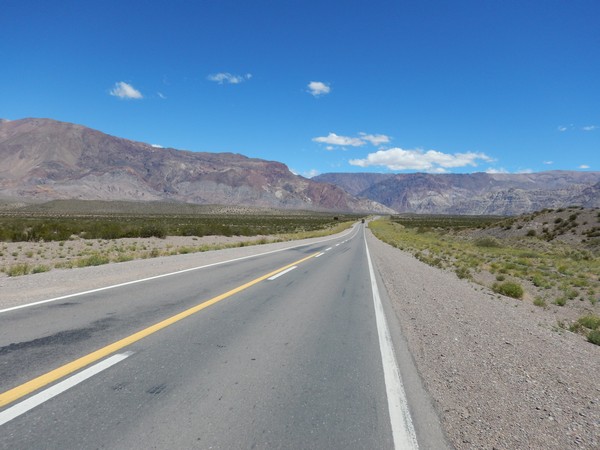
The next town of Los Penitentes was 40km away which would leave me an 80km final climb to the border the following day and so ideally I wanted to at least get there by nightfall.
I pushed on for another 14km following the Rio Mendoza which for the first time that day was now on my left.
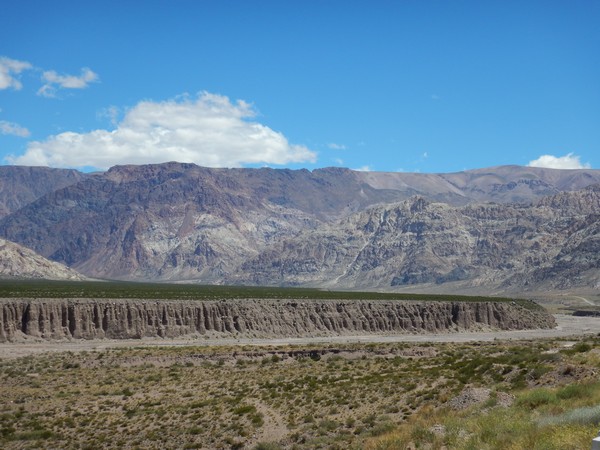
The ferocious gusts of wind here were unrelenting and on two occasions in short succession they blew me straight out into the middle of the road. The second time it was only because the car that was over taking me at the time had given me so much room that I avoided being knocked off the bike.
At that point I decided that it just wasn’t worth carrying on cycling as the wind conditions made it too dangerous. I could have physically pushed on but with my panniers acting as ‘sails’ that caught the wind there was no way I could keep the bike in a straight line.
I thought about stopping and camping but again there were no trees or wind breaks to protect my tent and so the only thing that I could do was to turn around and cycle back to Uspallata.
It had taken me over an hour and a half to cycle the 14km and with the slope and the wind with me I raced back hardly touching the pedals. The wind behind me was that strong that even at the couple of short uphill sections I didn’t have to hardly pedal as it just pushed me up them.
I then found myself a nice hotel and went to the pool for a soak and a beer.
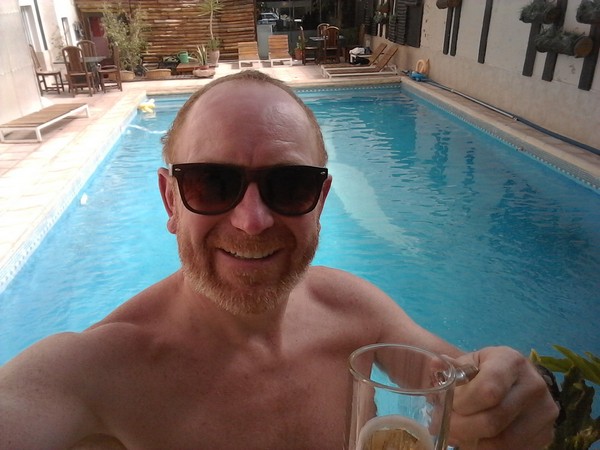
Having turned around meant that I was still over 100km from the border and the following day I really needed to get across the border and part of the way to Santiago in Chile as I was fast running out of time. I had a flight booked in 4 days time from Santiago to Turkey and in my schedule I should have been crossing the border the following morning.
There was nothing that I could do about the wind though and at times on a bike you have to let schedules go and stick with the safer option.
As long as the wind was kind in the morning I wanted to make a good attempt at reaching the border by the end of the day and decided as this could potentially be my last night in Argentina to treat myself to a big fat juicy steak at the local parrilla grill.
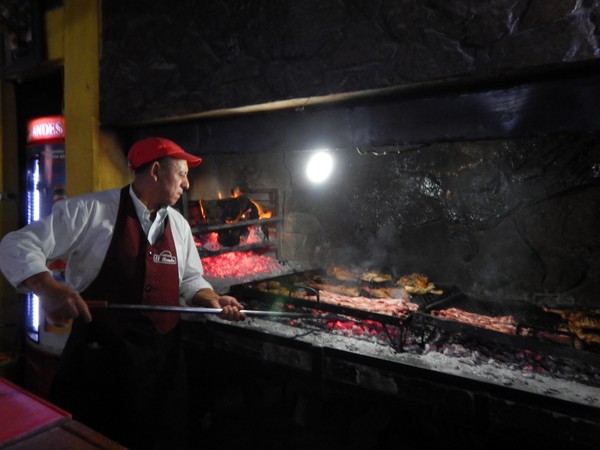
I was up early the next morning and had eaten breakfast and was on the bike by 7.30am. Thankfully the wind was light at that hour of the morning and if anything the slight breeze was behind me.
Where it had taken me 90 minutes to cycle 14km the day before that morning I had reached it in 40. If I was going to make the border by nightfall I had ahead of me nearly 2000m of climbing as this was the day where I would summit the pass that marked the border between Argentina and Chile.
When I set off on this ride mountains for me were best avoided but somewhere along the way I found my climbing legs and now would rather be cycling though hills than along coastal plains. Climbing over the Andes though was a different kettle of fish but that day I would find out if I had the legs for it.
Once I had passed the point that I had reached the day before all doubt about whether I had made the right decision had gone from my mind. In the past I have made some weird decisions whilst cycling tired, but yesterdays had been the right call as I couldn’t control the bike properly.
The valley significantly narrowed and the mountain tops that had yesterday been visible were lost in the rain clouds darkened the sky ahead of me.
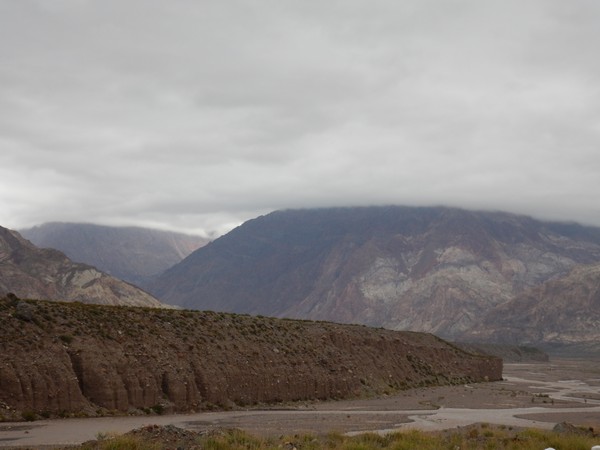
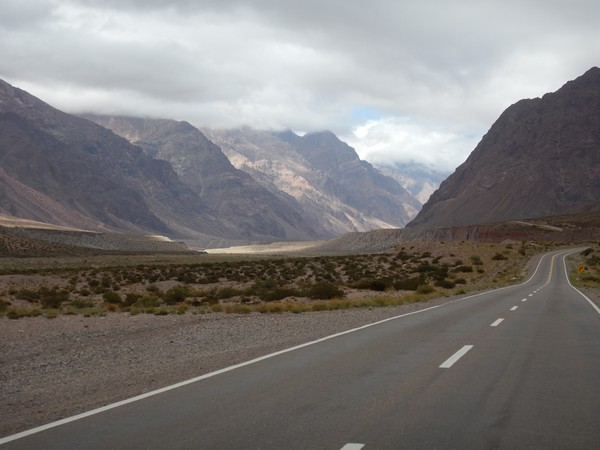
The incline of the road was noticeably much steeper now
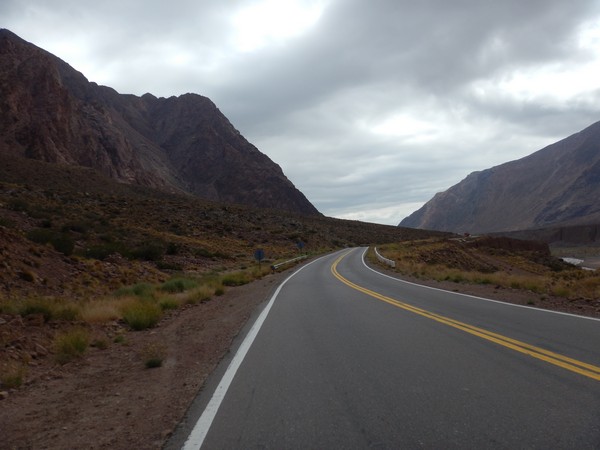
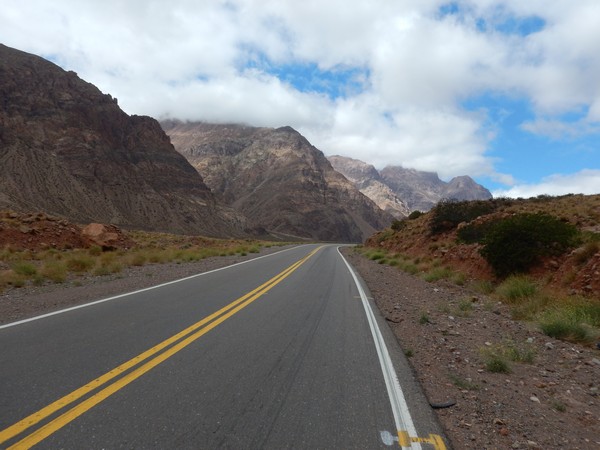
Where there had been roller coaster sections of road the day before the road was now just a constant uphill climb
 The mountain scenery was stunning
The mountain scenery was stunning
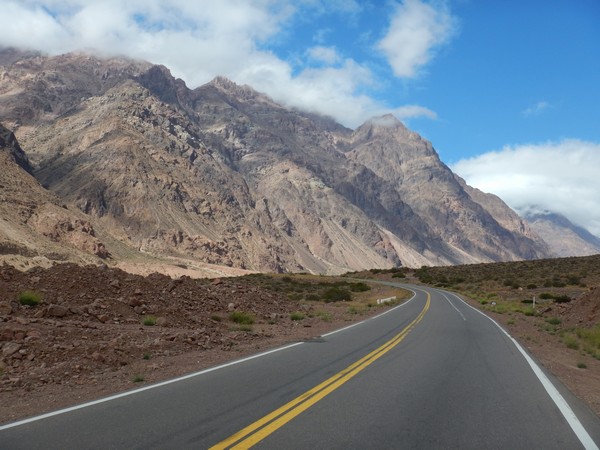
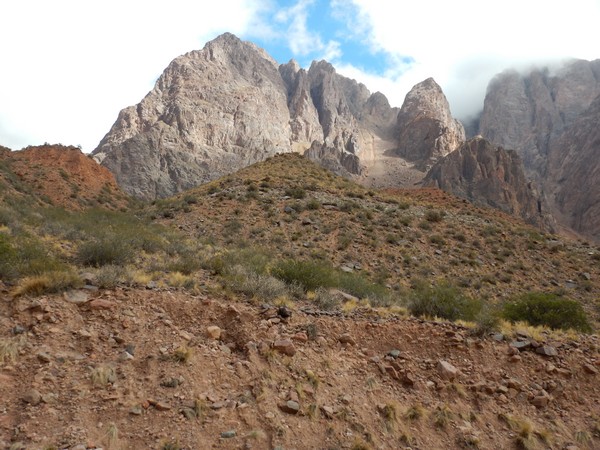
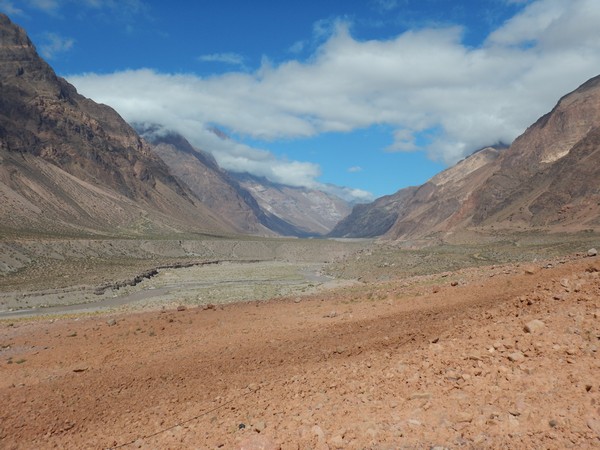
The valley that I was following was very narrow in parts
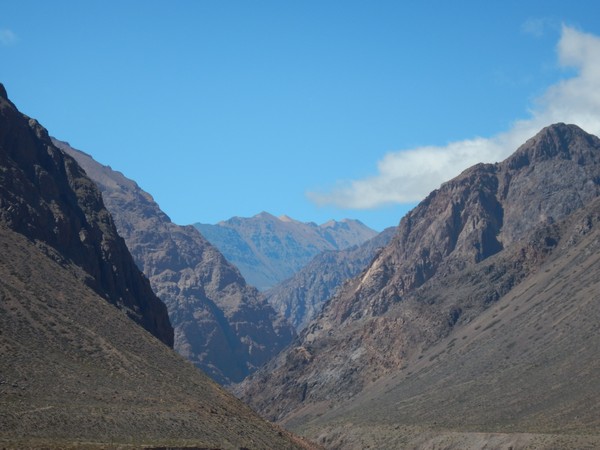
but would then as I rounded a bend suddenly open up into this magnificent vista where all you could say was wow.
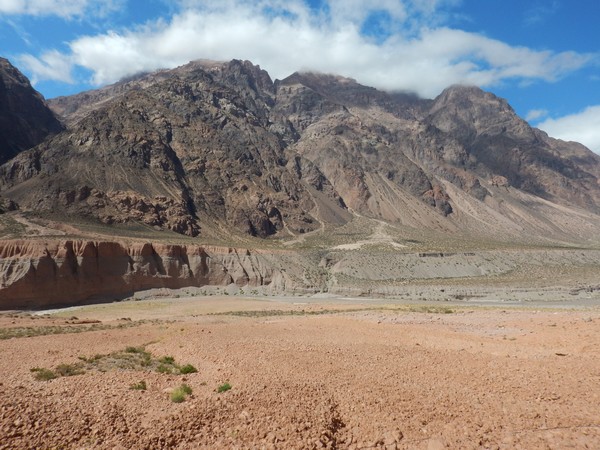

Up ahead on the road there was this huge wall of a mountain.
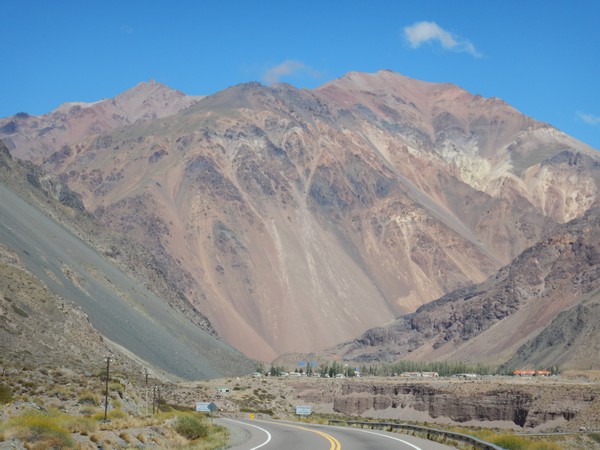
A quick check of the map showed me that although I wouldn’t have to cycle over the top of it I would have to cycle a good portion of it.
I had now cycled 40 km and had reached the village of Los Penitentes which I had planned to get to the night before.
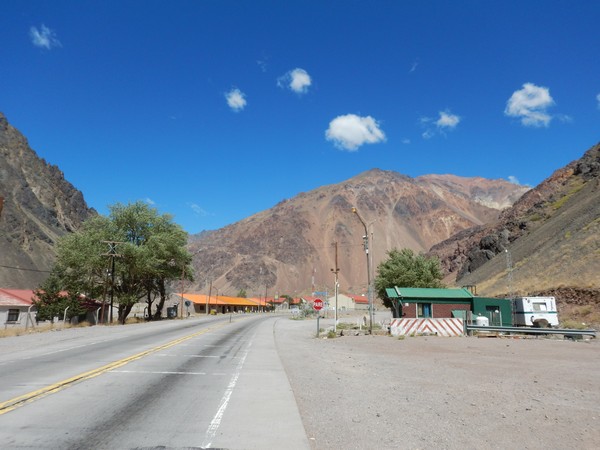
Just past the village down a side valley I could see the snow capped summit of Nevado Del Plomo which looked beautiful away in the distance. (It looked much bigger in real life than in the picture below)
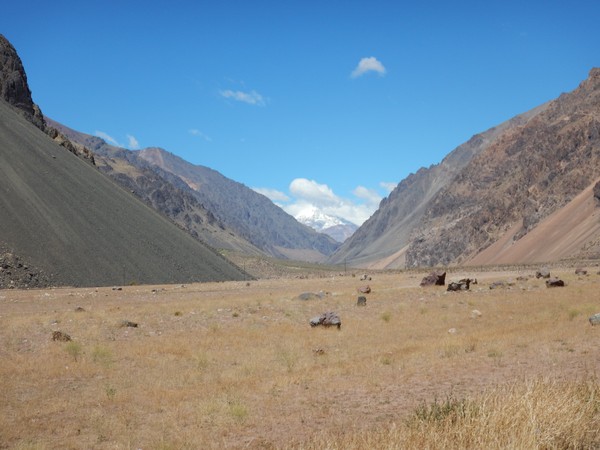
The steep valley sides here were barren of any vegetation and the view down the valley that I had just ridden up was beautifully stark.
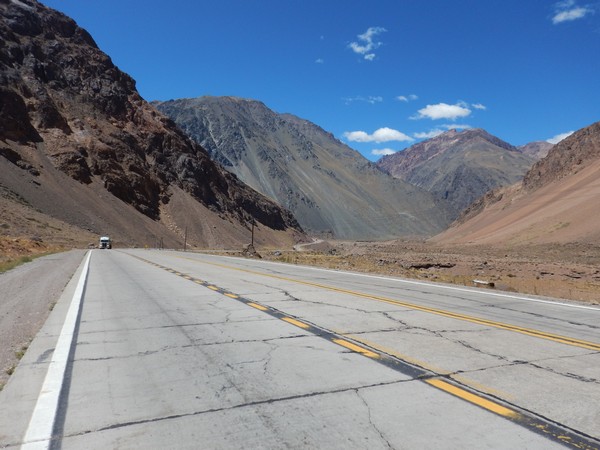
I was just thankful that the rains had held off as it would have been bloody miserable cycling up the valley in driving rain.
At the head of the valley I could for the first time see the summit which marked the frontier with Chile.
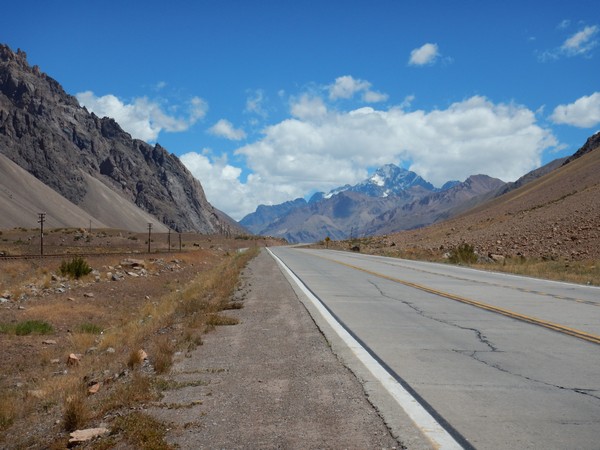
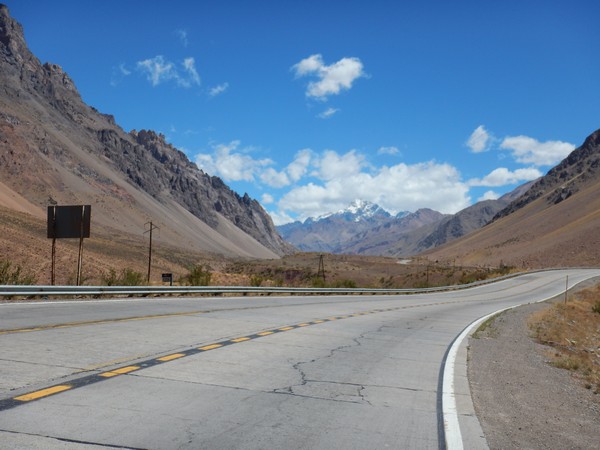 The village of Puente Del Inca lay in the shadow of the mountain and in winter was one of the main ski resort for the area.
The village of Puente Del Inca lay in the shadow of the mountain and in winter was one of the main ski resort for the area.
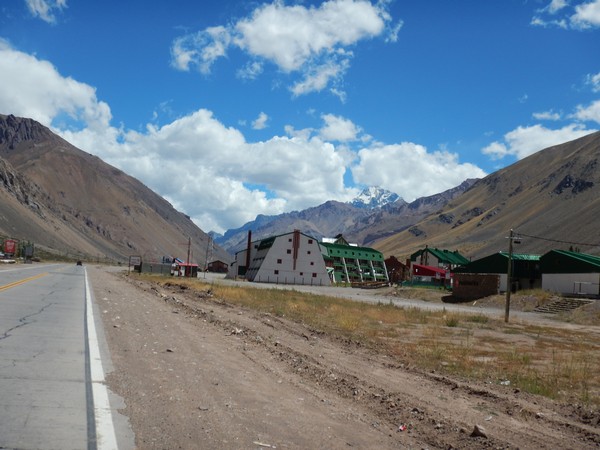
It was by now early afternoon and I had a choice to make. The summit of the mountain pass and Chilean border lay only 25km further up the valley but even though there was blue sky overhead further up the valley the weather was not looking so promising.
Most of the ski resort was closed for the summer but one of the hostals was still open and serving food. Over lunch I contemplated whether I should press on as I had already covered 80 km for the day, and even if I made the frontier I would still need to cycle another 20km to find somewhere to stay for the night as camping on the pass was not an option. This would my ride that day over 120km with nearly 2000m of climbing.
As I really wanted to make it into Chile that day I decided to head for the border and almost immediately when I set off I regretted the decision. Over lunch the bad weather that I had seen heading my way had arrived and the clear blue skies were gone
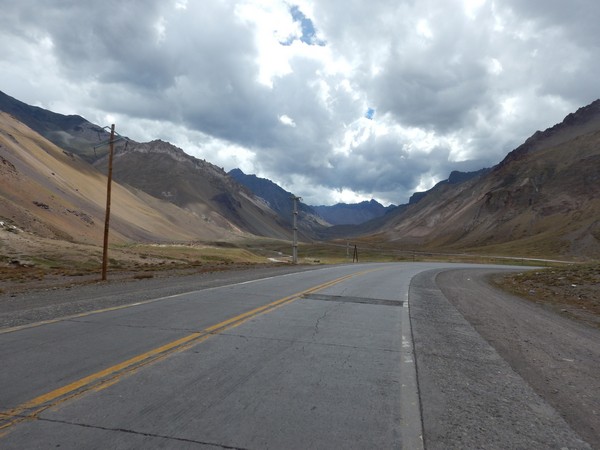
I could see rain falling away to my right and the wind had picked up considerably
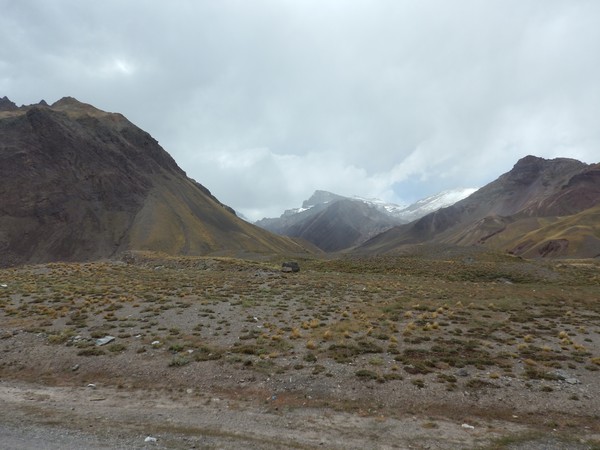
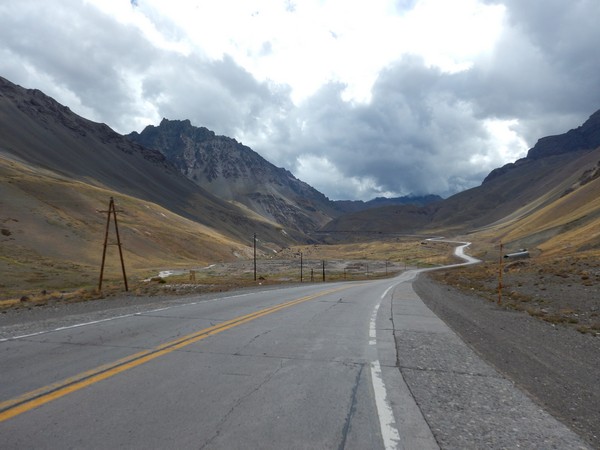 I now not only had the slope to contend with but a crazy headwind that had once again brought my pace down to a crawl. Where yesterday I had made the correct decision and turned around today the wind was blowing directly down the valley straight at me and so even though it was energy sapping it was not dangerous.
I now not only had the slope to contend with but a crazy headwind that had once again brought my pace down to a crawl. Where yesterday I had made the correct decision and turned around today the wind was blowing directly down the valley straight at me and so even though it was energy sapping it was not dangerous.
All the way up cars were honking their horns and people were shouting encouragement out of the window. I was determined not to get off and push the bike even though I’m sure it would have been faster.
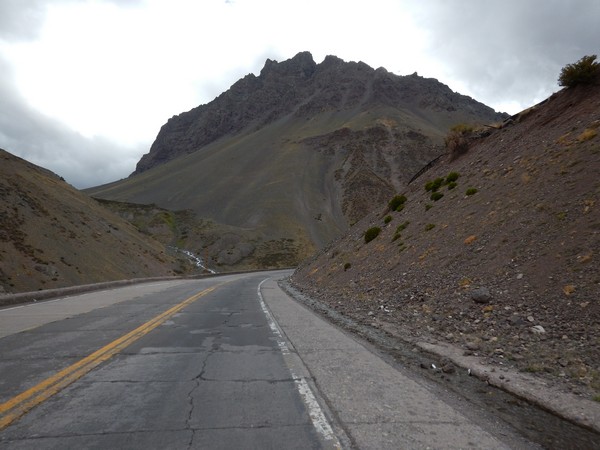
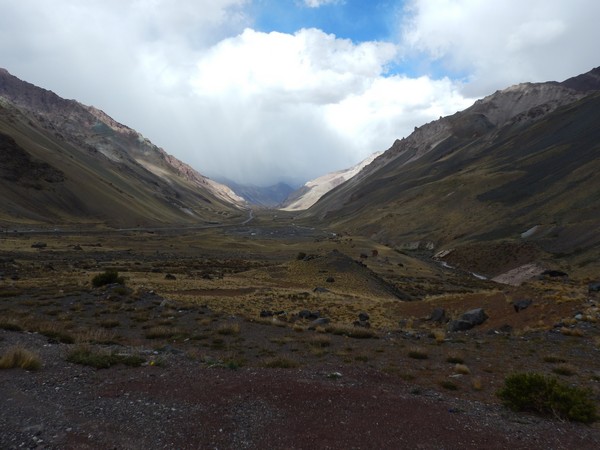
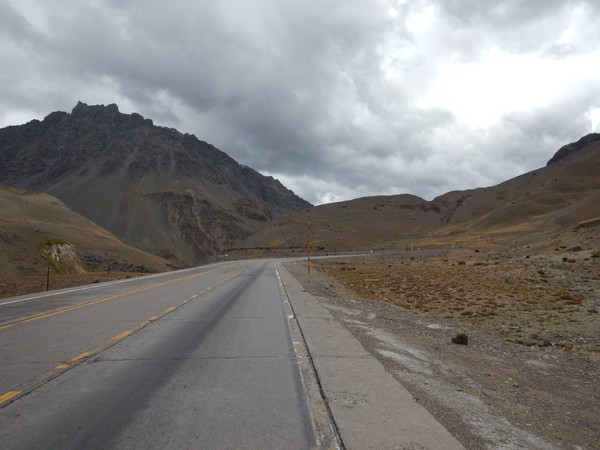
The short 25km distance to the border took me over 3 hours to cycle and at times with the slope and the wind I was cycling at 4kmph. I could have walked faster but cycling a 16kg bike, 20kg of extras and 70kg of me was sloooooow going.
As I neared the top of the pass it started to rain which, given the elevation and wind chill, soon turned to hailstones. The temperature was by now freezing but I didn’t want to stop to put on clothes as I was only a kilometer or so from the top. Even though I was starting to uncontrollably shiver and couldn’t feel my fingers I pushed on. (I told you that I made some weird decisions when tired)
Then, in front of me there was no more incline just a gentle rolling descent.
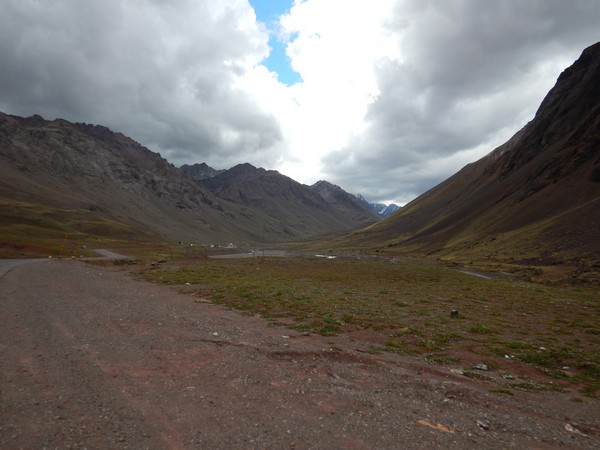
I was so happy to have pushed on through the crazy head wind and freezing temperature that even though there was no sign saying that this was the top I just knew that this had to be it (I honestly think that I would have cried if around the corner the road had climbed again)
Here is a video to show you some of the scenery I passed over the last 3 days:
It was time to get off the mountain though as the temperature was dropping rapidly and so after giving myself a pat on the back I cycled on down the gentle slope in front of me hoping that around the corner it continued to descend.
Even though the road had started to descend given the wind I was still struggling to cycle at a speed in double figures. Ahead of me I could see a toll booth and just ahead of it a tunnel.
When I reached the toll booth the staff told me that the bad news was that I couldn’t cycle through the tunnel. Instead, I would have to wait for a vehicle to come and collect me.
I was not sure what they meant but as they finished explaining a bright yellow pick up pulled up. I unloaded the panniers and the tent off the bike and the driver helped me to lift it into the back of the truck.
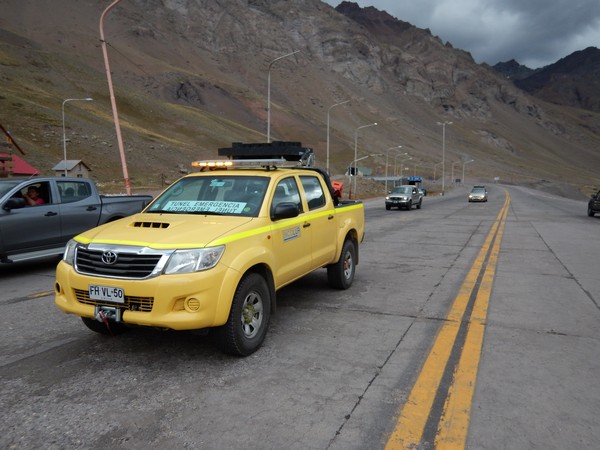
He then drove me through the tunnel and dropped me off on the other side.
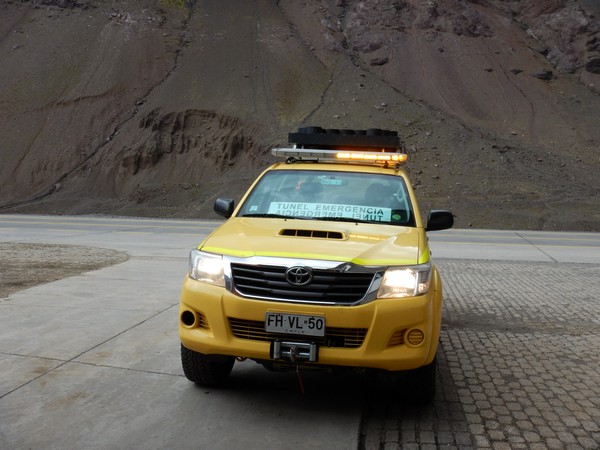
The border on a map between Chile and Argentina is at the centre of the tunnel even though the immigration posts are located further down the mountain. Thankfully, as most of the drive through the tunnel was uphill I had a lift:
The ride through the tunnel was only a few minutes but by the time that I had loaded the panniers back onto the bike and was ready to carry on I couldn’t stop shaking. It had been about 20 minutes since I had stopped cycling and now that the adrenaline of climbing to the summit had worn off the high altitude and freezing wind had got to me.
The driver said that the Chilean border post was only 4km down the mountain but there was no way that I could have safely ridden there and so before setting off I put on my thermal long johns on and a jumper and my high vis jacket to try and keep my upper body warm.
The 4km to the border post was total descent and so I was a passenger on the bike as I didn’t need to pedal once. My hands were freezing and my teeth were chattering so much that I had to cycle with my mouth wide open to stop my teeth clattering against each other.
I was so glad when I reached the border post as it was like a warehouse where all cars had to enter and be inspected before being allowed to pass. There was a long line of traffic but I just whizzed straight past them and into the warehouse. Once I was inside out of the wind the temperature difference was amazing and I just parked my bike and sat in a chair until my teeth stopped chattering (which took a good 5 minutes).
Now that I was warmer and in control of my body it was time to get on with leaving Argentina and entering Chile. The first task I was told was to go and get something called Pacs – this turned out to be a piece of paper saying that I had brought a bike across the border with me. Once I had this I was the told to go to the Chilean passport control which I did even though I hadn’t been to the Argentinian one yet.
It turned out that at this border crossing you don’t have to officially leave Argentina as your Chilean entry stamp proves that you left the country. Apparently, when coming the other way it is the same – you don’t get a Chilean exit stamp only an Argentinian entry stamp.
It was a good job as without knowing it I had passed the Argentinian border post 15km back. If you are in Argentina and cycling towards the border you will pass a group of buildings on your right where the road splits and traffic from Chile have to drive into. This is the Argentinian border post and I would have definitely camped in the warehouse for the night if they had tried to send me back up the mountain to go get an exit stamp.
There was still one last thing to do before I was fee to enter the country – have my bags scanned and inspected. There was a huge queue of people from coaches already lined up with their luggage. It was already early evening and I still had 20km more before coming to a village which had accommodation.
I decided to chance my arm and to cycle out without getting inspected. I pushed my bike to the far end of the warehouse and thought I had got away with it when somebody asked me for my paperwork. They saw that I hadn’t got a stamp and told me so in Spanish. I played the dumb tourist and said that didn’t understand what he was saying.
He pointed at the queue of people and told me in English to go. I shrugged my shoulders to show I still didn’t understand. He then called one of his colleagues over to take his place and he walked me back to the inspection area. Instead of taking me to the back of the long line of people he walked me to the front and told me to take my rear panniers off which I did.
He then put them through the scanner for me and brought them back. Within 2 minutes I had gotten the stamp I needed and was cycling out of the warehouse. Sometimes being a ‘dumb’ tourist works.
Now for the fun part – the descent. I knew that on the Chilean side of the border there was something known as ‘The 29 curves’. These were a series of switchbacks where you descend more than 600m in a very very short distance
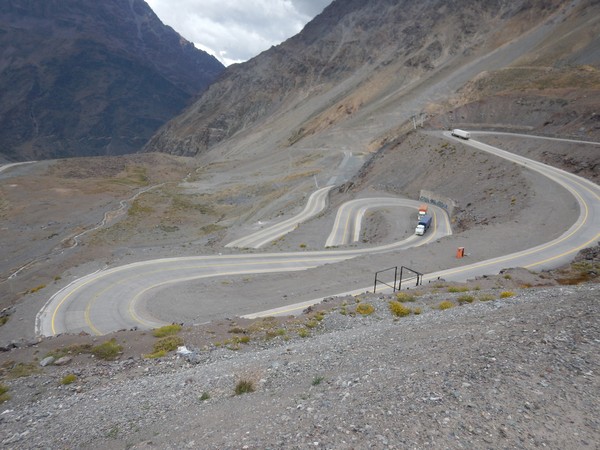
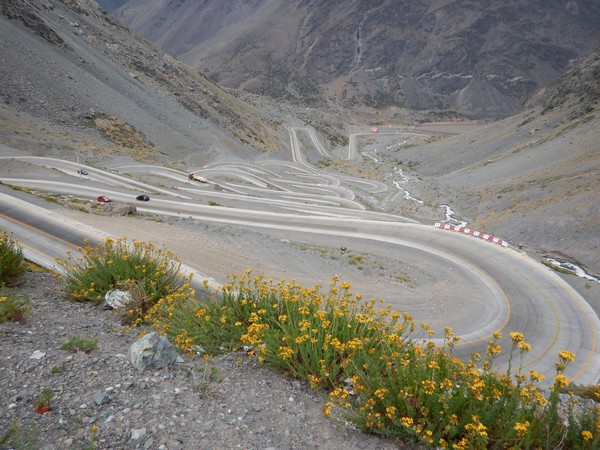
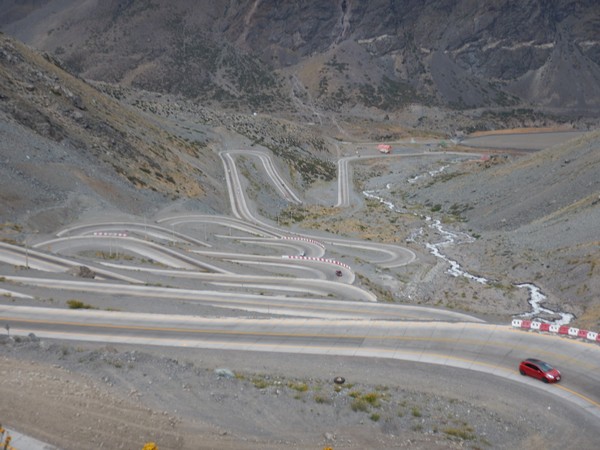

This was so much fun even though on the straights of each of the curves the side wind was blowing me all over the road I was now overtaking the trucks that had been passing me for the last 3 days.
It was so much fun sweeping around the tight curves and was like being on a giant luge. I was glad that I was descending though as the climb up to the border would have been horrendous.
Once out of the curves it was time to descend down the valley
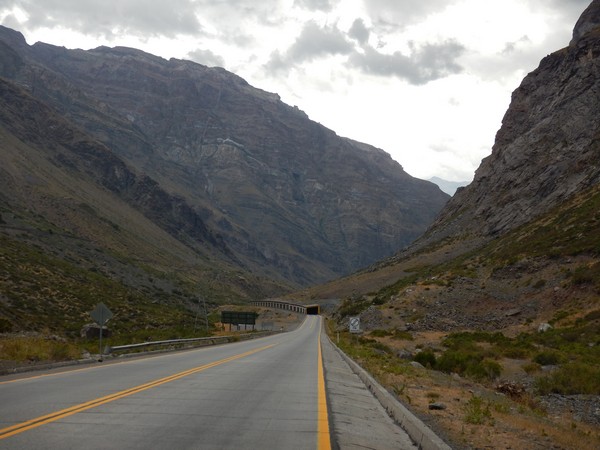
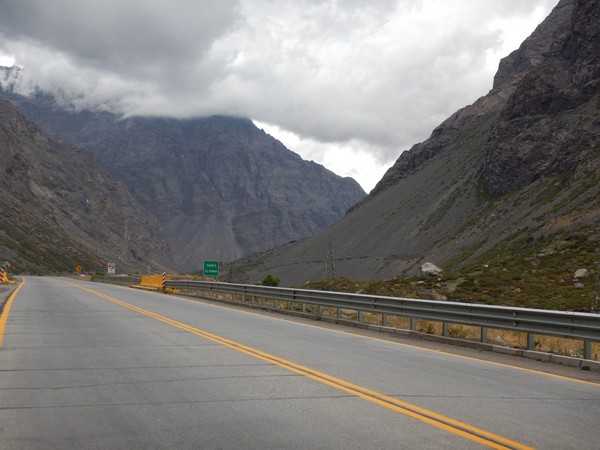
The condition of the road here was terrible – it was concrete slabs with big joins every 10 metres that bounced you out of your saddle and in each of the slabs huge bits of concrete were missing. Instead of enjoying the view around me whizz past I spent the next 20 minutes staring at the road looking for holes.
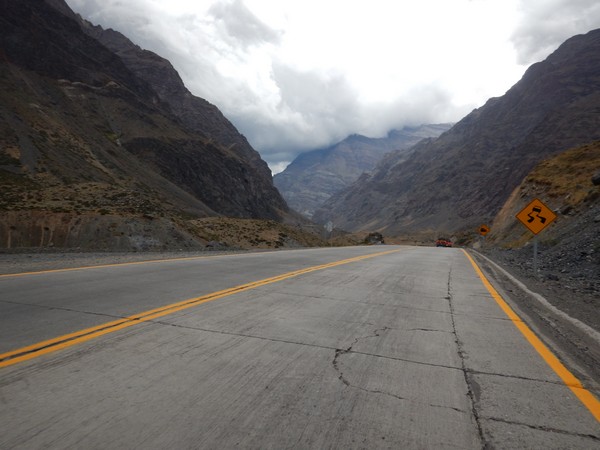
After hitting a hole at speed and near falling when taking a photo I had to stop every time I wanted to get the camera out so in the end gave up taking photos as the weather behind me was closing in and I could hear rolling thunder.
As I reached the village of Peralillo the heavens opened and the rain was bouncing off the road. That was me done for the day and I pulled into the next place that I passed to get a room for the night.
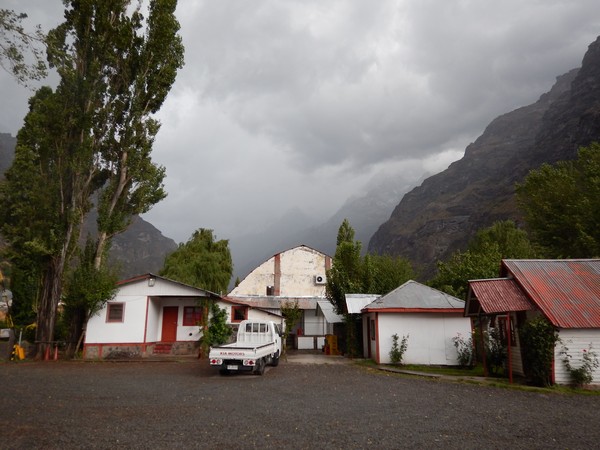
That day I had cycled 125 km, climbed nearly 2000m and crossed the border into Chile. The wind had been horrendous, the temperature freezing but at least the worst of the rains had held off right until the end of the day.
In the 3 days since setting out from the wine region of Maipu I had cycled 230 km through gale force headwinds and climbed 4000m over the top of the Andes. I think that I can finally say that I have found my mountain legs.
If you would like to automatically receive all future posts straight to your email inbox please just add your details to the form at the foot of this page.
Great job Steve! Amazing, now you are in Chile, just as planned. Enjoy and keep us posted.